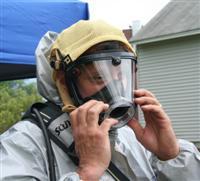Hazardous Materials Emergencies: "We Learn Something Every Time"
 |
| City firefighter David Simon donned the protective clothing necessary for a hazardous materials decontamination situation. [Photo by Jen Thomas] |
 |
| City firefighter David Simon donned the protective clothing necessary for a hazardous materials decontamination situation. [Photo by Jen Thomas] |
| If you would like to contribute information on this article, contact us at info@iberkshires.com. |